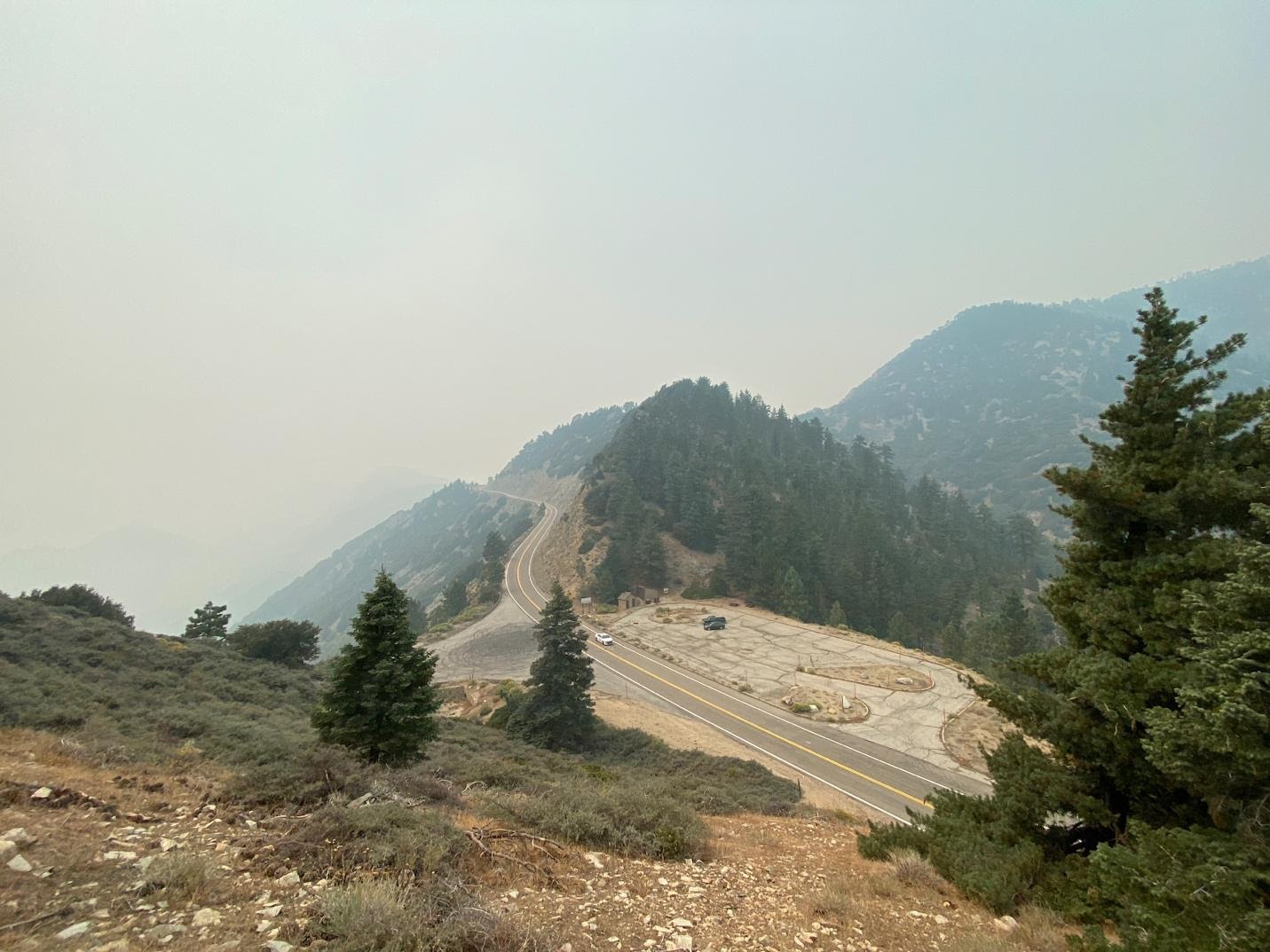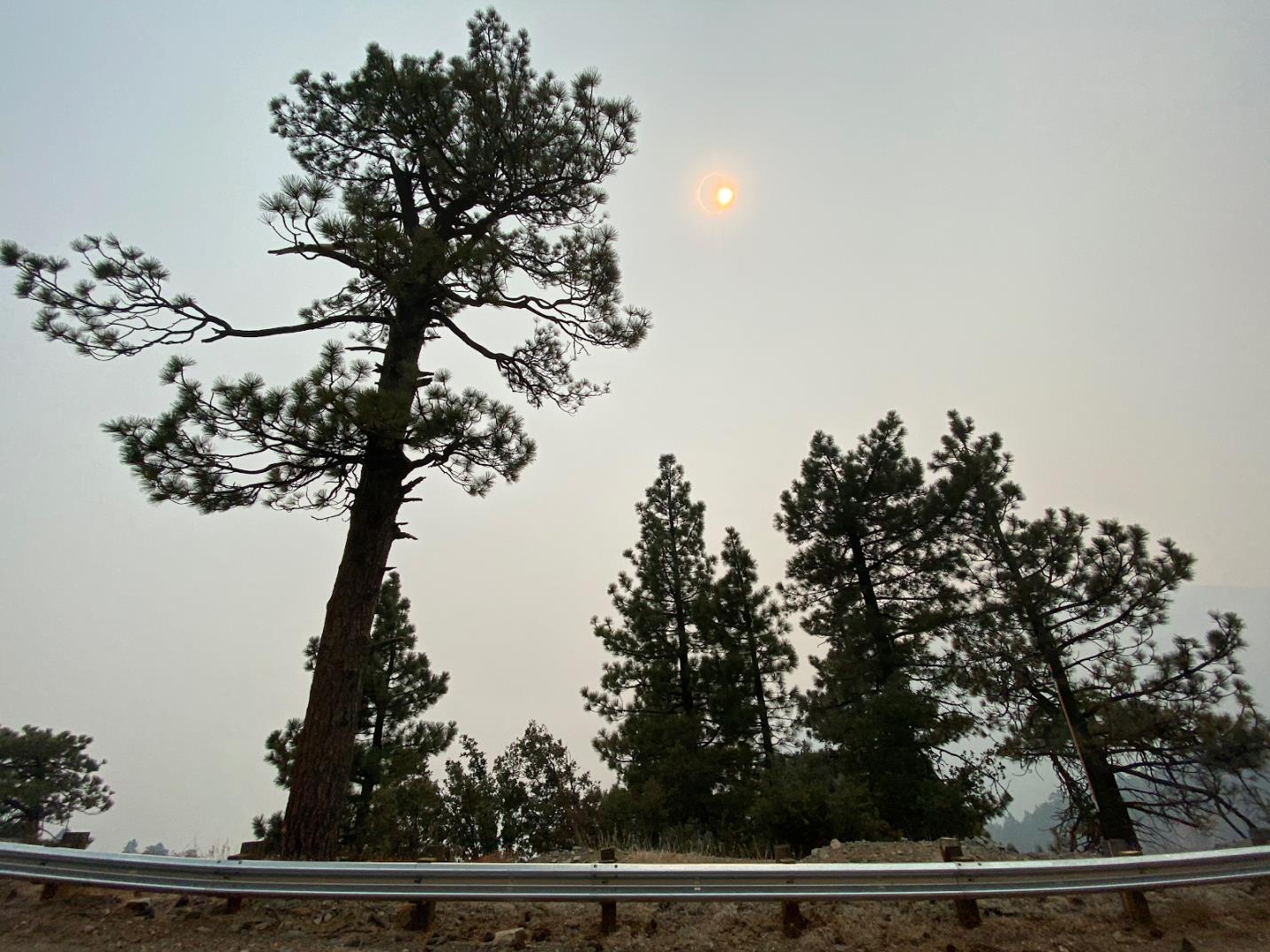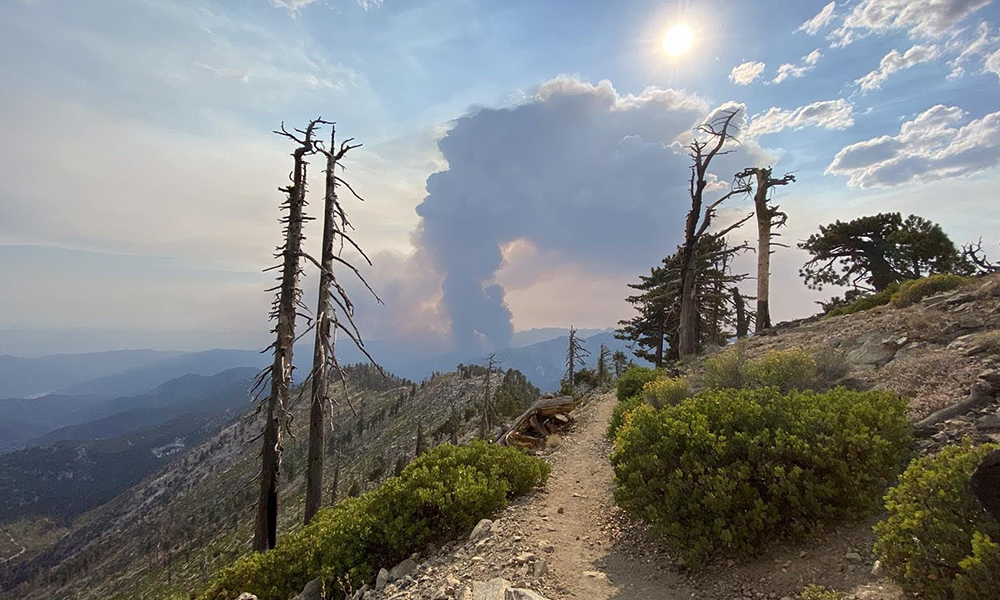It was just after 1:30pm on Sunday, September 6, 2020, when we turned a corner on the hike up to Mt. Islip, an 8,250-foot-high mountain accessible by a slight detour from the Pacific Crest Trail (PCT) in the Angeles National Forest with sweeping views of the San Gabriel Mountains. Smoke rose a few miles south of us, from near Cogswell Dam, in a dramatic curve as it looked to meld with the clouds. On occasion, we could see the red-orange of flames around the mountainside.
“What are you doing hiking out here in the smoke?” a group of day hikers asked us jokingly. The smoke hadn’t yet reached us, but it was readily apparent it would eventually. The fire, which we now know as the Bobcat Fire that has consumed over 100,000 acres and threatened wildlife, foothill communities, and the Mt. Wilson Observatory, had begun just an hour prior. It was just one of many fires that have hit California this year, with a record-breaking 4 million acres burned so far.
“Did it just start?” another hiker asked, concerned. Like us, she had probably checked the news before coming and was relieved to see no fire danger in Southern California at the time. She’d backpacked up alone to spend the night before hiking up Mt. Baden Powell on Monday, an even taller mountain peak directly along the PCT.
It wasn’t immediately clear what was going on. Without mobile service, we weren’t sure if the authorities had been notified, though it seemed reasonable to assume they saw it too. The wind was moving down from us, but we weren’t experienced enough with gauging forest fire movement to be certain. We comforted ourselves with the knowledge that the flames themselves seemed safely ensconced on other side of the mountains ahead of us.
Upon descent, we arrived at our campground, and a couple asked us if we’d seen a ranger. Should we be evacuating? In all my hiking in the national forests, it was rare to see a ranger. Unlike the national parks, designed and coded explicitly for recreation, it always feels like national forests are more rugged. I knew we were on our own to figure things out.
¤

In January 2020, I began reading about the emergent novel coronavirus. A long-time writer about China and an amateur public health nerd, I paid attention to it more than most people in the United States, fascinated by how novel viruses emerge and how they can force the shutdown of Wuhan. I knew the city’s size viscerally and intellectually, having visited before on a weeklong trip along that Yangtze River. With a population almost equal to that of New York and Los Angeles combined, Wuhan ground to a halt was difficult for me to imagine.
It is always tricky to get reliable information from mainland China. Due to both language barriers and censorship and firewall mechanisms, I’ve long learned to take news from China with a grain of salt. Any news needed questioning and vetting. Like determining whether there’s life on Venus, China watchers like me know to wait and see, reading the signs but waiting before accepting initial reports as fact.
As I write this nearly ten months later, there is still so little we know about what we now call SARS-CoV-2, the virus that causes COVID-19. Leaping from Iran to Italy and the rest of the world, we learn bits and pieces from scientists, journalists and politicians, sometimes in contradiction of each other. The most evocative example of this, of course, was the debate over whether or not to wear masks. In the early days, I heard the conflicting reports, just like everyone else: masks do little to stop the spread; save masks for healthcare workers; definitely wear masks to protect others from illness in case you’re an asymptomatic spreader; it looks like masks might help protect you, too.
Since the many surprise political events of 2016, much of the world has been focused on the challenges of misinformation (unintentionally incorrect or misleading information), and disinformation (intentionally misleading information often pushed by people with a political or commercial agenda). Indeed, the confusion around masks is but one recent tally in the countless conspiracy theories, misinformation, and disinformation that have swept through the public imagination in recent years.
But the frameworks of mis/disinformation haven’t been enough to describe quite what’s going on. The challenges right now are somewhere in the middle, something I’ve been calling midinformation, because we don’t quite know where things stand with the virus. Do we get long-term immunity? Are children truly safe? What are the major risk factors? Will a vaccine be ready next year, and if so, how effective will it be? Good-faith actors just don’t know, or if they do, they don’t agree.
Like a fire, the COVID-19 pandemic burns and twists, and we have to read the headwinds and hope the authorities and experts figure it out and let us know. People like us are largely on our own to practice basic public health measures until the picture becomes clearer.
¤

Back at camp, my first instinct was to get my walkie talkies and tune the radio to the weather station operated by the National Oceanic and Atmospheric Administration (NOAA). We left it on for a while as it cycled through news update, and the only information we could glean was that the San Gabriel Valley area had an increased fire risk. We couldn’t figure out any updates on the novel fire itself.
Fortunately, we found a spot on the camp site that could reach cell service. My first instinct was to check the National Forest Service site, which didn’t have any immediate updates, and the phone line had closed by the time we figured out the number. The Los Angeles Times and Laist had coverage of the fire but no clarity on its spread or effects on the Angeles National Forest (understandably, they were more focused on the impact on city dwellers).
“I’m… I’m not an internet researcher,” my partner told me. “Can you figure it out?”
d the web and determined that the Angeles Forest Twitter account and Cal Trans Twitter were updated regularly. I gleaned some information from ready.lacounty.gov, which had some basic fire updates, and Apple Maps, which told us about road closures along the 2 and 39 highways (surprisingly, Google Maps at the time didn’t). Having written a book on internet culture, I was used to navigating the many tangled threads of online content to make order out of disorder. As an experienced internet researcher, I had the skills to collectively help us understand the specific dangers facing us, and once we had the information, we made a best guess that the fire wasn’t moving in our direction. Like the other campers at our site, we decided to stay rather than risk hiking down the PCT in the rapidly-approaching darkness.
We could have been wrong. The fact that you’re reading this today means that we were right — the Bobcat Fire didn’t grow much more that night, even though it was 0% contained. (Others, like those caught in the Creek Fire near Fresno, were less fortunate and had to be evacuated en masse.)

It shouldn’t be this way. Professional internet researchers shouldn’t be the only ones able to figure out the news in an emerging crisis. This is not a knock on the US Forest Service. With backcountry backpacking, we take personal responsibility for our own safety; the rangers are busy enough trying to care for the forest that it’s incumbent on campers and backpackers to practice good care in the wild.
With the Bobcat Fire, my backpacking partners and I experienced a type of information challenge that’s not quite misinformation or disinformation, but missing information — fragmented sources of news, emerging knowledge, and low bandwidth amongst good-faith actors. It was a microcosm of the COVID-19 information crisis in so many ways, where we have to glean reality from the WHO, CDC, and numerous scientists and television personalities and preprints.
The explosion of available information with the rise of the internet is worth celebrating, but we’re becoming more familiar with its costs. With these larger public health and societal health issues, the messiness of the Information Age has become a liability. There’s a lot of new technology infrastructure, political norms, and communications practices that need to be built to help people navigate something arguably more complicated than mis/disinfo: confusion when no one, not even experts, quite knows what’s true.
By Monday morning, we packed our bags. We were hoping to stay the rest of the day, but we learned on Twitter that the entire forest was being shut down as a precaution. Overnight, smoke had wafted throughout our campgrounds and obscured what had been a magnificent view of the Mojave Valley. Our hike down the Pacific Crest Trail back to our cars gave us gorgeous flowers, winding trees and a sense of floating through a Chinese landscape painting covered in ashy mist. Like the skies over California, the fog of the internet is beautiful in its wilderness and deadly in its bewilderment.
An Xiao Mina is author of Memes to Movements and co-author of the forthcoming Hanmoji Handbook. She works at Meedan.


